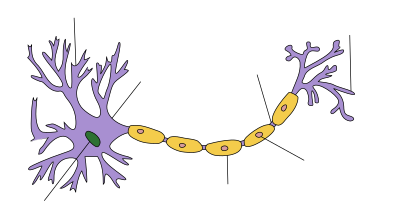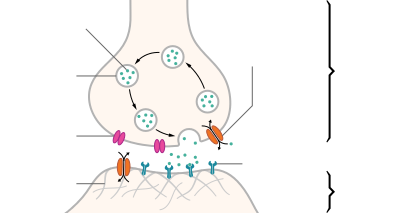Axonal projection
| Axon |
|---|
| Structure of a typical chemical synapse |
|---|
An axon (from Greek ἄξων áxōn, axis), is a long, slender projection of a nerve cell, or neuron, that typically conducts electrical impulses away from the neuron's cell body. Axons are also known as nerve fibers. The function of the axon is to transmit information to different neurons, muscles and glands. In certain sensory neurons (pseudounipolar neurons), such as those for touch and warmth, the electrical impulse travels along an axon from the periphery to the cell body, and from the cell body to the spinal cord along another branch of the same axon. Axon dysfunction has caused many inherited and acquired neurological disorders which can affect both the peripheral and central neurons. Nerve fibers are classed into three types – A delta fibers, B fibers, and C fibres. A and B are myelinated and C are unmyelinated.
An axon is one of two types of protoplasmic protrusions that extrude from the cell body of a neuron, the other type being dendrites. Axons are distinguished from dendrites by several features, including shape (dendrites often taper while axons usually maintain a constant radius), length (dendrites are restricted to a small region around the cell body while axons can be much longer), and function (dendrites usually receive signals while axons usually transmit them). All of these rules have exceptions, however.
Axons are covered by a membrane known as axolemma; the cytoplasm of axon is called axoplasm.The branched end of an axon is formed by telodendra; the swollen end of a telodendron is known as the axon terminal; which joins the dendron or cell body of another neurone forming a synaptic connection.
Some types of neurons have no axon and transmit signals from their dendrites. No neuron ever has more than one axon; however in invertebrates such as insects or leeches the axon sometimes consists of several regions that function more or less independently of each other. Most axons branch, in some cases very profusely.
...
Wikipedia


